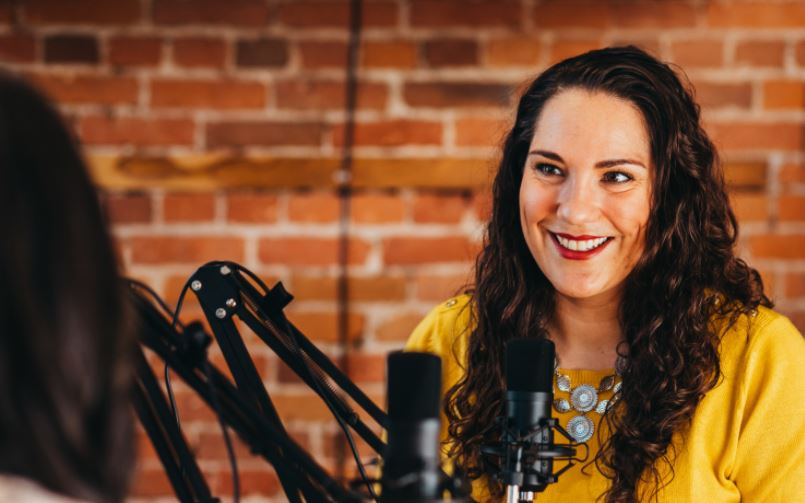Reporters and producers forced to come up with ‘creative solutions’

Amanda Cupido, a podcast producer and a Ryerson School of Journalism instructor, sits in her Toronto apartment, using her yoga ball as a chair. Cupido is no longer able to go to in-person events and interviews due to the pandemic, so she listens back to some of her previous episodes, thinking about the best way to replicate the auditory experience — all while living and working remotely.
“I’ve created stories in ways that I had never been pulled to before,” she says, adding that it’s given her work a wider range.
Last August, Cupido produced a podcast episode for Ryerson’s virtual Pow Wow. Pre-pandemic, when Cupido could record sound bites and interviews in-person, she says she felt more in control of what her work could look like. For the 2020 live-streamed event, she was sent a YouTube link instead, where she snipped parts of the audio and layered it throughout the episode, attempting to bridge the gap restrictions caused in production.
“I’m being forced to come up with creative solutions,” she says, adding that she considers the challenges an opportunity for growth. “I’ve become a better producer because of the pandemic.”
***
The world seemed to stop moving in 2020: schools Zoomed, businesses closed and quarantines ensued. We were faced with gripping fear and uncertainty as we were thrown into a swift and indefinite lockdown. For journalists, there were no more in-person networking events where you can shake hands with fellow reporters, no more colleague collaborations in the editing suite before going live, and no more quick check-ins to flesh out new ideas while you pass by your editor’s office. All of these changes affect journalists, Ryerson students and staff, every day.
***
CBC education reporter Deana Sumanac-Johnson also had to find alternatives to the way she’d been doing her job for years. She says she misses collaborating with her colleagues, landing in a new city, doing her hair and makeup in the airport bathroom and going live. Now she sits alone, with her iPad on the dining room table in her townhouse. There is no cameraperson to help direct her, nor colleagues just down the hall. Now she has to light, frame and shoot her setup shots alone. Back when she was in the field, Sumanac-Johnson always received direction from the cameraperson. As she puts it: “In terms of providing you with the shots you need, really getting a feel of the scene and of what something is like, our camera people are absolute heroes.”
She says Google Meet and Zoom cannot replace the feeling of being in her element at the studio and on the job. “I think for most reporters who are such people, who love leaving their house, and love meeting new people and feeling the environment…(the isolation) is tough,” says Sumanac-Johnson. Sitting alone, waiting for the right light to come streaming through the windows of her home for her to do her standup, if anything, makes her appreciate every member of her CBC team more.
As with Sumanac-Johnson, these technologies cannot replace in-person collaboration for Anand Ram, a producer for CBC. Ram even had to teach some of his colleagues how to record their guests on Zoom and Google Meet. The bustling CBC newsroom has been reduced to a lone webcam on his desktop in his basement. At the end of the day, “It’s not just what you file — it’s how you help people do their jobs,” Ram says. “It’s who you connected with that day; it’s how you helped other people be able to succeed and put some journalism up.”
Cupido teaches the Advanced Podcasting and Radio Documentary course at Ryerson and says being able to report both remotely and in-person will make her students assets in the workplace. “I predict that they will be going into interviews where they might even know more than their employer.”
Third-year journalism student Masih Khalatbari says he thinks about the lost ride-alongs he planned with Toronto’s police force, as part of his freelance reporting. He laments how the pandemic has affected his journalism program, including lost networking opportunities, as isolation creates barriers for student journalists to find each other and themselves. “This is the stage where we’re supposed to kind of find ourselves and where people say it’s gonna be the best years of your life. And we’re experiencing something completely different than other generations are,” says Khalatbari.
For Julia Sacco, a second-year Ryerson journalism student, the flood of pandemic headlines can be inescapable. “I do think there’s limitations on both the quality we can produce and the quality that we can consume,” she says, though she admits reaching out to editors online about writing opportunities is easier than in person.
Khalatbari says he worries that online classes leave out the best part of Ryerson’s journalism program. “It’s pretty much all application and putting you into the field, and we’re just blatantly missing out on that,” Khalatbari says. “All these programs are learning to kind of compensate for it; this might not be the most helpful thing for the industry once we get out of the pandemic.”
***
Last winter, Cupido stood in the cool Canadian breeze interviewing a subject. This would be the last in-person interview she would do for the foreseeable future. Mask and mic on, she slipped a small mesh cover over the microphone for sanitation — something she only started doing in the last year. She interviewed the subject outdoors, disposing of the mesh afterwards. In this way, Cupido has found that there are feasible solutions to the technical problems brought on by the pandemic. “You have to be creative to work around obstacles,” she says. “You’re not going to approach the story in the same way, but the journalistic integrity is not any different.”
With files from Pia Araneta
